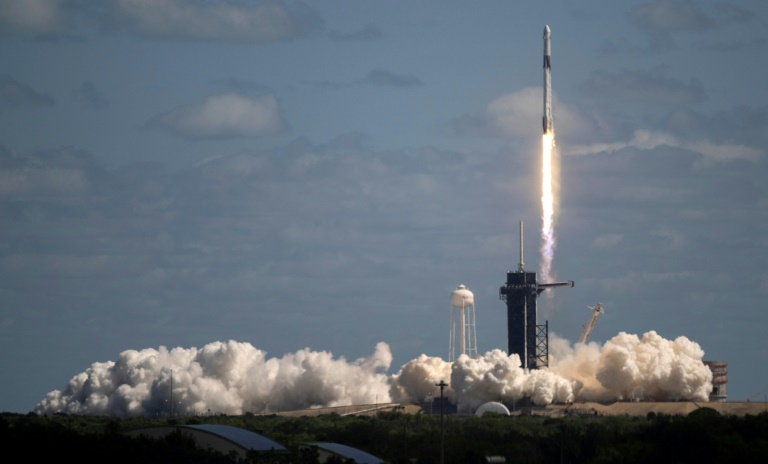One of SpaceX's Falcon 9 rockets, which the European Space will use to launch two missions
The European Space Agency announced Thursday it will use SpaceX’s Falcon 9 rockets to launch two scientific missions because of delays to its own Ariane 6 rocket and the cancellation of flights on Russia’s Soyuz launchers.
The ESA’s space telescope Euclid had been planned to launch next year on a Soyuz rocket, but in February Russia pulled out in response to European sanctions over Moscow’s war in Ukraine.
Euclid, which aims to better understand the mysteries of dark energy and dark matter, will now instead catch a ride into space on the Falcon 9 rocket of billionaire Elon Musk’s US company SpaceX.
The ESA’s Hera mission, which will probe the Didymos asteroid that NASA successfully knocked off course in September by smashing the DART spacecraft into it, will launch on a Falcon 9 in late 2024, ESA director general Josef Aschbacher said.
The use of other launchers was “a temporary measure” for the ESA due to the “drop out of Soyuz in particular,” but also over the Ariane 6 delay, Aschbacher told a press conference.
The ESA previously used a Falcon 9 to launch European-developed radar altimeter satellite Sentinel-6 Michael Freilich in 2020.
The European-Japanese EarthCARE observation satellite had also been planning to reach space on a Soyuz rocket, but will instead take the ESA’s lighter new Vega-C launcher in early 2024, Aschbacher said.
Tensions over the war in Ukraine also led to a long postponement for the once joint European-Russian ExoMars mission. It had been scheduled to launch last month using a Soyuz rocket to put European rover Rosalind Franklin on Mars to drill for signs of life.
David Parker, the ESA’s director of human and robotic exploration, said a 2028 ExoMars launch date would be proposed to the agency’s 22 members states at a ministerial council in late November.
“It is exactly one month since we would have been at the launch, which was scheduled for September 20,” he told the press conference.
“But now we will have to wait — if the ministers desire to go forward with the project — until launch in 2028, with a landing in 2030,” he said.
– Ariane 6 delayed again –
Thursday’s announcement came a day after the ESA revealed that Ariane 6’s maiden flight had been delayed again, and will now launch in the last quarter of next year.
Originally planned for 2020, the inaugural flight of the Ariane 6 has previously been postponed by the Covid-19 pandemic as well as development difficulties.
The replacement for the highly successful Ariane 5 is hoped to eventually take over the ESA’s Soyuz missions. Once in operation it is likely to compete with SpaceX rockets, particularly when it comes to sending small satellites into the sky.
Some 18,500 satellites weighing less than 500 kilogrammes are expected to be launched into space over the next decade, according to advisory firm Euroconsult.
Progress has made in recent days on the Ariane 6, including a test of the new upper stage of the rocket’s engine at a German space site in Lampoldshausen.
Aschbacher said the first 45-second firing test was “extremely successful,” calling it an “important milestone”.
A test model of Ariane 6 was also recently successfully assembled on the launchpad of Europe’s spaceport in French Guiana’s Kourou.









